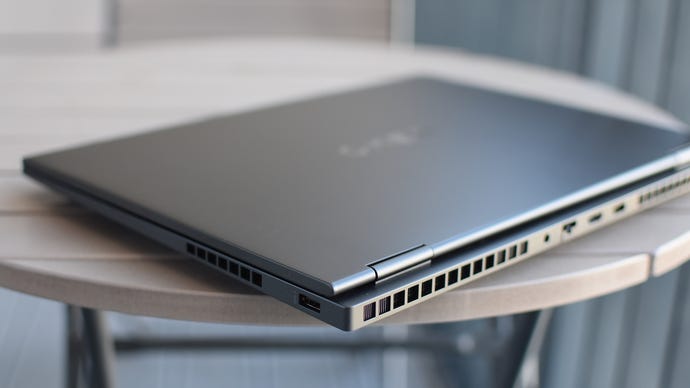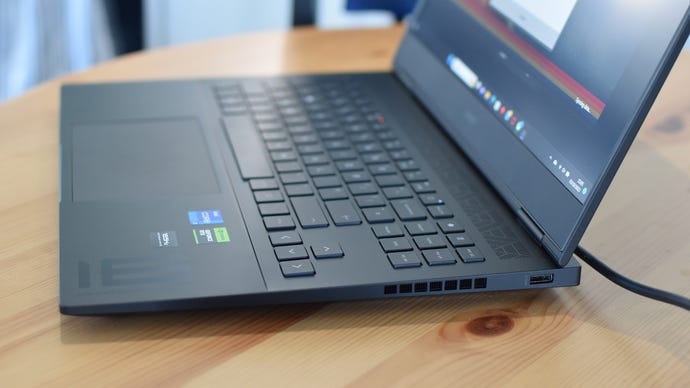HP Omen Transcend 16 review: a slim and proper gaming laptop
Lean slate
Even with the rising power of integrated graphics, the prospects of getting high-quality, high-rez gaming capability in a laptop of ultrabook proportions is still years from becoming a feasible reality. Until then, slimmer gaming laptops like the HP Omen Transcend 16 remain the closest approximation of that dream, cramming discrete GPUs – the Nvidia Geforce RTX 4060, in this case – into lighter, narrower chassis designs.
The usual catch with such devices, sadly, is an overeagerness to appear aspirational. Which is, to be clear, the nicest thing I can say about a Razer Blade 16 costing £2500 for its own RTX 4060 model. Despite the name, however, the Omen Transcend 16 is much more down to earth – it still offers enough premium trappings to feel like a step up from chunkier laptops, but at its current pricing of £1199 / $1429, it’s a fair trade as well. And it supports Nvidia DLSS 3, dash of futureproofing tech that might just soothe any worries about buying a 2023-spec PC in 2024.
Not that the Omen Transcend 16 is lacking in modernity otherwise. The slimline bodywork cuts a sharp figure, happily short on unnecessary flourishes (coloured WASD keys notwithstanding) and smartly moving a lot of the ports to the rear edge, where plugged-in cables can’t clutter up your mouse-swishing space. Those connections are high-spec, too, with HDMI 2.1 and two Thunderbolt 4-ready USB-C ports as standard. I would have traded one of the latter for a third full-size USB-A port, admittedly, but two is more than enough for games duty. The webcam also enables face sign-in for Windows, another convenience which always worked quickly and flawlessly on my bespectacled mug.
At 2.2kg, the Omen Transcend 16’s weight is well below average for a 16in gaming notebook. You can go even lower with some 14in and 15.6in models, naturally, but this is a good shoulder-sparing option if you specifically want a larger laptop that still takes an occasional backpack trip. There benefits to the size, to be sure: the chiclet keyboard is comfortably proportioned, as is the (massive) trackpad. The keys won’t singe your fingers, either, as HP’s twin-blower cooler works well enough to keep the internals from broiling the chassis. Expect plenty of fan noise when running games, mind – the speakers can drown it out, but a headset makes for a worthwhile accessory.

The 1920x1200 display, meanwhile, is excellent. It’s a vibrant, IPS screen that covers 98.4% of the sRGB colour gamut, and its peak brightness and contrast ratio are – at 472cd/m2 and 1255:1, respectively – the highest I’ve personally tested in years. Nvidia G-Sync support and a 165Hz refresh rate also give real gaming credentials that are backed up in normal use, with little to report in the way of ghosting, tearing, or undue blurring. The 1920x1200 resolution is less exciting, being just a hair above boring old Full HD. Or, in other words, not that many pixels to spread across a 16in panel. Still, it looks sharp enough, and at least the resolution isn’t overtaxing that RTX 4060.

As such, the Omen Transcend 16 can comfortably run games (and individual quality settings) that are simply beyond those other options for lightweight PC gaming,: handhelds like the Steam Deck and Lenovo Legion Go. It will handle Starfield on our recommended settings, and with some upscaling help from DLSS, it can even get Psycho-quality ray tracing running well in Cyberpunk 2077: 48fps on average, with everything else on Ultra. Add in DLSS 3 frame generation, and that jumps up to 76fps.
The rest of our usual gaming benchmarks confirm the RTX 4060 as a capable, if rarely outstanding mid-range mobile GPU. It easily beats the laptop-grade RTX 3070 at native resolution, with smooth results like 73fps in Total War: Three Kingdoms, 92fps in Assassin’s Creed Valhalla, 88fps in Forza Horizon 5, and 91fps in Horizon Zero Dawn. Those were all on their Ultra (or highest equivalent) presets, so there’ll usually be no need to drop settings.

That said, ray tracing is still best accompanied by some upscaling, even at 1200p. In Watch Dogs Legion, the Omen Transcend 16’s initial 70fps result (on Ultra quality) fell to 40fps with the addition of Ultra RT effects. That’s still playable, but as Cyberpunk 2077 shows, whacking on DLSS (or AMD FSR, depending on the game) is an easy way to keep both quality and performance on the higher side.
In pure performance terms, then, this is a decent gaming laptop for the money. Though it is less impressive as a multipurpose workstation, a semi-shortcoming owed to its Intel Core i7-13700K processor. It’s fine for games, but lacks multitasking prowess, scoring just 6012 in the Cinebench R20 multicore test. That’s less than half what the Asus ROG Strix Scar 17’s AMD Ryzen 9 7945HX produced, though to the Intel chips’s credit, both scored an identical 714 in the single-core benchmark. See? Fine for games, especially older ones that don’t make extensive use of multithreading.

It's harder, unfortunately, to find the bright side of the Omen Transcend 16’s battery life. HP claims light usage will allow it to keep trekking for nearly eight hours, but under the cosh of running an actual game, that kind of longevity is nowhere to be seen: I got just 53 minutes into Shadow of the Tomb Raider before the full battery ran dry. That was with screen brightness on max, but otherwise on a pretty everyday batch of settings. It’s particularly disappointing to see this degree of draining on a thin-and-light gaming laptop, one that’s surely designed as such for superior portability.
The SSD is nothing special, either. With an AS SSD sequential read test result of 4357MB/s, and a sequential write result of 1970MB/s, it’s only really faster than what you’d get on budget laptops like the Gigabyte G5. The drives inside higher-end notebooks, including the ROG Strix Scar 17, will regularly outpace it.
And yet, those won’t always have the lovely build of the Omen Transcend 16, nor the display quality, nor the range of tools for keeping framerates high. Its short-livedness is frustrating, but if you want the general capabilities and svelteness of a Razer Blade without the self-imposed financial ruination, this will certainly do the job.









